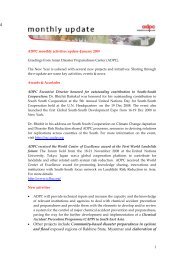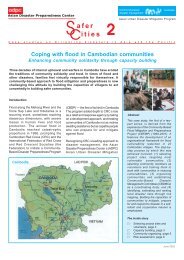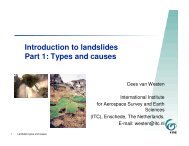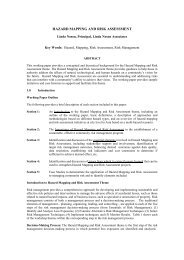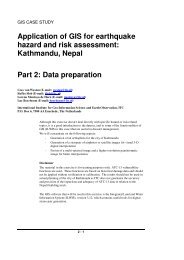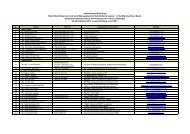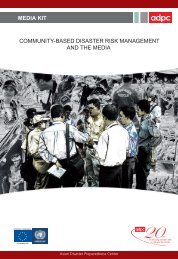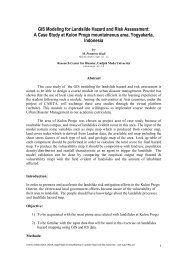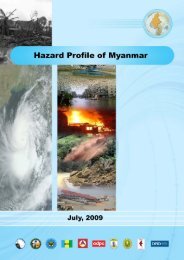The Cyclone Preparedness Programme in Bangladesh, Regional
The Cyclone Preparedness Programme in Bangladesh, Regional
The Cyclone Preparedness Programme in Bangladesh, Regional
Create successful ePaper yourself
Turn your PDF publications into a flip-book with our unique Google optimized e-Paper software.
a) High Frequency (HF) Transceiver radios, with a ma<strong>in</strong> base station located at the Dhaka<br />
Headquarter, with the function to transmit <strong>in</strong>formation related to the cyclone and the<br />
preparedness. From the field stations the local <strong>in</strong>formation related to the progress and effects of<br />
the cyclone is sent to Dhaka HQ.<br />
b) A Field station system of very high frequency (VHF) transceivers with the function to<br />
receive and transmit messages from HF Field Stations to Sub-Stations located at Union level.<br />
c) Transistor Radios used by each unit Team leader (2733 teams) with the function of<br />
receiv<strong>in</strong>g meteorological <strong>in</strong>formation and cyclone warn<strong>in</strong>g signal bullet<strong>in</strong>s transmitted by Radio<br />
<strong>Bangladesh</strong> Special Weather Bullet<strong>in</strong> on regular basis dur<strong>in</strong>g the time of cyclone or depression.<br />
<strong>The</strong> HF Transceivers (Field Stations) of the CPP have been <strong>in</strong> operations from 1972 and the<br />
VHF (field Sub station) s<strong>in</strong>ce 1990. S<strong>in</strong>ce the end of 1995, the telecommunication network<br />
covers almost 80 % of the estimated needs of the coastal belt. Dur<strong>in</strong>g after the cyclone of April<br />
1991, the HF and VHF transceivers were the only means of communication from the coastal belt<br />
of <strong>Bangladesh</strong> and proved their effectiveness before, dur<strong>in</strong>g and after the cyclone. <strong>The</strong> network<br />
has been as important asset for the post-cyclone relief operation to enable rapid collection of<br />
essential <strong>in</strong>formation from the affected areas and to transmit operational directives to the relief<br />
teams as it may proved aga<strong>in</strong> dur<strong>in</strong>g 1994 and 1995 cyclone.<br />
CPP is now operat<strong>in</strong>g a total of 115 Radio stations, out of which, 60 stations are located <strong>in</strong><br />
cyclone shelters, built by the BDRCS, <strong>in</strong> the high risk cyclone prone areas. Almost all these<br />
radio stations are powered by solar panels with storage batteries. <strong>The</strong>re are now 25 stations were<br />
both HF/SSB and VHF/FM Radio transceivers are operat<strong>in</strong>g, and there are 8 stations where only<br />
HF/SSB Radio transceivers are operat<strong>in</strong>g. Only VHF/FM Radio Transceivers are operated <strong>in</strong> 82<br />
stations.<br />
10. WARNING EQUIPMENTS AND<br />
GEARS FOR VOLUNTEERS<br />
I. Warn<strong>in</strong>g equipments :<br />
To receive the meteorological storm warn<strong>in</strong>g signals, the Unit Team leaders are provided<br />
with a transistor radio.<br />
To dissem<strong>in</strong>ate the warn<strong>in</strong>g signals among the villagers megaphones, sirens, public<br />
address equipments, signal lights and signal flags are provided to each volunteers team.<br />
II. Volunteers gears :<br />
To facilitate the volunteers movement <strong>in</strong> the cyclonic adverse weather, they are provided<br />
with ra<strong>in</strong> coats, gum boots, hard hats, life jackets and torch lights.<br />
Beside these, the first aid & rescue volunteers are provided with first aid and rescue kits.<br />
16



